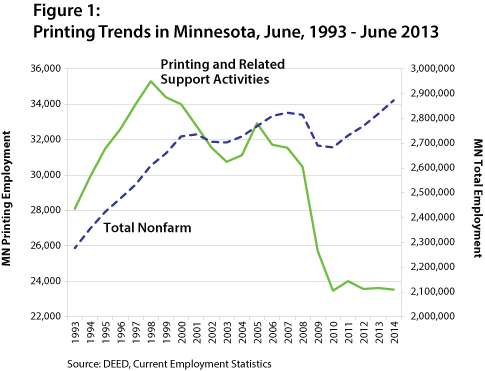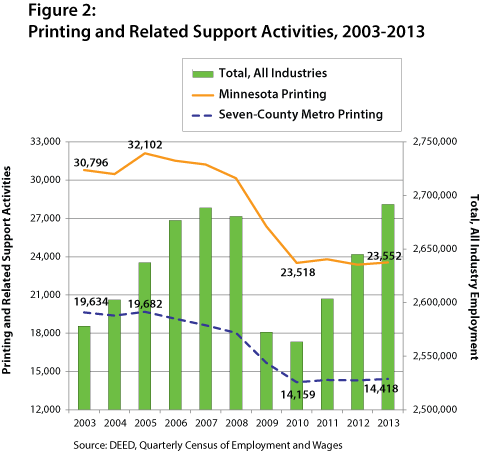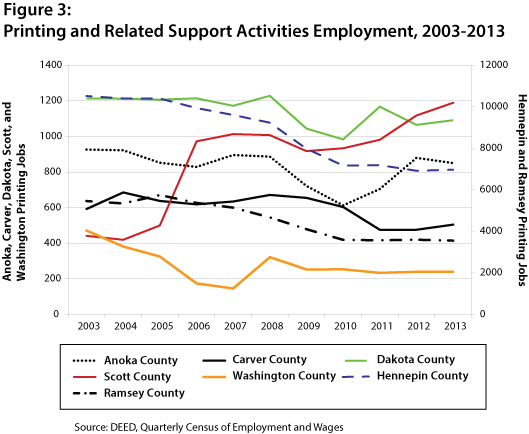by Tim O'Neill
June 2014
Despite the proliferation of new job searching technologies, some job seekers still go to the printed edition of the newspaper to find work. If companies are hiring, job seekers can still read all about it, thanks to the printing industry.
According to the North American Industrial Classification System (NAICS), the Printing and Related Support Activities subsector includes those industries that print products such as newspapers, books, labels, business cards, stationary, business forms, and other materials and perform support activities such as data imaging, platemaking services, and book binding. The major printing subsector is further organized by Commercial Printing, Commercial Screen Printing, Books Printing, and Support Activities for Printing.
Printing industry statistics can be observed and analyzed through the Current Employment Statistics (CES) Program, a monthly survey of nearly 6,000 employers in the state that provides a snapshot of overall economic health as well as specific industry statistics. As of June 2014, Printing and Related Support Activities employed 23,536 Minnesotans. While this barely represents 1 percent of the state's total employment, it represents approximately 7.4 percent of the state's total manufacturing employment. So while a smaller industry overall, printing is not something to write off.
Printing witnessed its golden age in the early to mid-1990s. Between June 1993 and June 1998, printing in the state grew by 7,200 workers or 25.6 percent. This was well above the 14.6 percent growth rate for the total of all industries. Just over half of those additional printing workers, 3,900, were gained in the Minneapolis-Saint Paul Metropolitan Statistical Area (MSA).
However, printing began to suffer severe employment declines across the state beginning in 1998. In the 12 years between 1998 and 2010, statewide printing employment plummeted by 33.5 percent, while the total of all industries grew at 2.3 percent. Within the Minneapolis-Saint Paul MSA, the printing job cuts were even more severe at 40.1 percent. Numerically, the state lost 11,826 printing employees between 1998 and 2010; more than 80 percent were in the Minneapolis-Saint Paul MSA.
Fortunately, the hemorrhaging has recently ceased, especially in the Minneapolis-Saint Paul MSA. Between 2010 and 2014, while printing in Greater Minnesota continued to decline by 4.3 percent, the Minneapolis-Saint Paul MSA regained 444 printing workers for a 3 percent increase. While the printing industry is still largely stagnant statewide, the four years between 2010 and 2014 hint at a stabilization (Figure 1).


The Quarterly Census of Employment and Wages (QCEW) tool allows us to analyze printing in the metro area more closely. This tool includes those establishments covered under the Unemployment Insurance Program which covers about 97 percent of Minnesota employment.
Through 2013 there were 727 printing establishments with 23,555 jobs in Minnesota. Of those, 459 printing establishments with 14,418 jobs were in the Seven-County Metro Area, making up about three-fifths of total state printing employment. Commercial Printing (except Screen and Books) makes up the lion's share of printing employment. In the Metro Area, for example, 11,455 people were employed in this industry sector, making up nearly 80 percent of the region's total printing jobs. The average annual wage in Commercial Printing is nearly identical to the average annual wage for the total of all industries (Table 1).
| Table 1: Printing and Related Support Activities 2013 Sorted by Employment | |||||
|---|---|---|---|---|---|
| NAICS
Code |
Industry Title | Firms | Employment | Average
Annual Wage |
2012 - 2013
Employment Change |
| Minnesota | |||||
| 0 | Total, All Industries | 165,051 | 2,691,763 | $50,128 | +1.8% |
| 323 | Printing and Related Support Activities | 727 | 23,555 | $50,544 | +180 (0.8%) |
| 323111 | Commercial Printing (except Screen and Books) | 539 | 18,815 | $50,388 | +147 (0.8%) |
| 323113 | Commercial Screen Printing | 126 | 2,678 | $39,520 | +81 (3.1%) |
| 323120 | Support Activities for Printing | 54 | 1,764 | $71,136 | -47 (-2.6%) |
| 323117 | Books Printing | 8 | 298 | $39,312 | +0 (0.0%) |
| Seven-County Metro Area | |||||
| 0 | Total, All Industries | 79,133 | 1,618,006 | $56,524 | +1.7% |
| 323 | Printing and Related Support Activities | 459 | 14,418 | $57,512 | +114 (0.8%) |
| 323111 | Commercial Printing (except Screen and Books) | 340 | 11,455 | $56,472 | +214 (1.9%) |
| 323120 | Support Activities for Printing | 44 | 1,678 | $72,748 | -52 (-3.0%) |
| 323113 | Commercial Screen Printing | 72 | 1,240 | $44,148 | -85 (-6.4%) |
| 323117 | Books Printing | 3 | 8 | $42,900 | +1 (14.3%) |
| Source: DEED Quarterly Census of Employment and Wages | |||||
Job vacancies reported by printing firms in the Twin Cities MSA region follow this same pattern. According to DEED's Job Vacancy Survey, printing vacancies dropped from their high of 751 in the fourth quarter of 2005 to 13 vacancies in the fourth quarter of 2009. Vacancies have gradually increased since 2009 to 107 vacancies reported in the fourth quarter of 2013.
The QCEW data allow for closer regional analysis. For instance, when zooming in on the Twin Cities MSA, two key findings emerge. First, the bulk of metro printing employment is in Hennepin and Ramsey counties. While not surprising, these two counties account for nearly three-fourths of total metro printing employment. Second, although printing employment has dropped throughout the metro region, Scott County has shown remarkable growth in this subsector. Between 2005 and 2010, while every other county shed printing workers, Scott County's printing subsector grew by 86.8 percent. The county continued to expand by 27.4 percent between 2010 and 2013, joined in growth only by Anoka and Dakota counties during that period (Table 2 and Figure 3).
| Table 2: Printing and Related Support Activities in the Seven-County Metro Area Sorted by Employment | |||||
|---|---|---|---|---|---|
| Area | 2013 Annual Data | 2005 - 2010 Employment % Change | 2010 - 2013 Employment % Change | ||
| Firms | Employment | Average Annual Wage | |||
| Hennepin County | 233 | 6,976 | $56,108 | -31.0% | -2.8% |
| Ramsey County | 97 | 3,555 | $63,856 | -37.5% | -1.1% |
| Scott County | 13 | 1,190 | $59,176 | 86.8% | 27.4% |
| Dakota County | 47 | 1,092 | $51,688 | -18.5% | 11.0% |
| Anoka County | 46 | 851 | $47,944 | -28.1% | 38.8% |
| Carver County | 7 | 505 | $57,148 | -5.3% | -16.4% |
| Washington County | 17 | 240 | $49,816 | -22.1% | -5.5% |
| Source: DEED Quarterly Census of Employment and Wages | |||||

The current makeup of the printing industry in the Twin Cities is markedly different from the labor market as a whole. In terms of gender, while the overall labor market is nearly even between male and female workers, the printing industry's workforce is approximately 65 percent male and 35 percent female.
In terms of age, the printing industry is significantly older when compared to the whole economy. More specifically, 53 percent of the printing workforce is 45 years of age or older, compared to 42 percent for the entire metro workforce. At the other end of the spectrum, approximately 6 percent of the printing workforce is 16 to 24 years of age. This compares to 13 percent for the entire metro workforce.
Finally, in terms of educational attainment, the printing industry has lower educational requirements. Employers have reported an average of 16 percent of printing vacancies requiring post-secondary education in the past five years. This compares to 42 percent of all vacancies requiring post-secondary education.
There is no doubt that the printing industry has witnessed a significant decline in the nation and state in recent history. Certainly the advent of new digital communication technologies has had an impact on the strength of printing. However, the printing industry still employs more than 14,400 people in the Twin Cities MSA, more than 23,500 in the state and more than 450,000 at the national level. With new, more sustainable printing technologies becoming available, as well as emerging technologies like 3-D printing, the printing industry will continue to remain an important part of the economy.